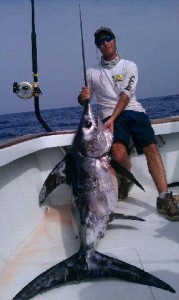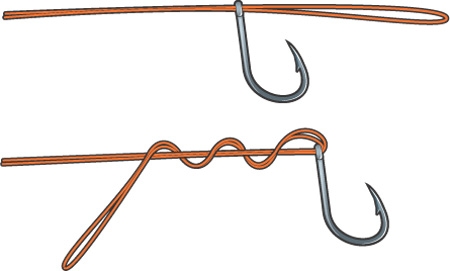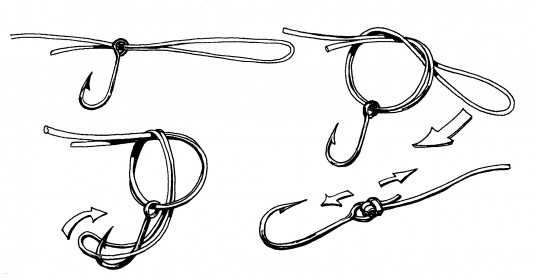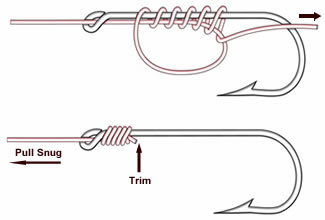Using strong, durable, and reliable knots offshore is a lesson every saltwater angler learns at some point in their career. Of the thousands of variables you can’t control when fishing offshore, tying strong, durable knots is one of the few keys to success which rests in your hands…literally. Whether you’re rigging baits ahead of time or prepping a pitch bait on the fly, mastering these essential offshore knots will help you to land that fish of a lifetime, and can give you the upper hand when a fish fight plays out longer than expected.
Line to Leader Knots:
- Double Uni Knot
- Albright Knot
- Bristol Knot
- Seaguar Knot
- Yucatan Knot
Loop Knots
- Bimini Twist
- Perfection Loop
- Spider Hitch
Leader to Hook or Lure
- Uni Knot
- Tuna Knot
- Palomar Knot
- Snell a Hook
- Haywire twist
The Double Uni Knot
This is one of the most common, and toughest, line to line connections you can tie. We use this knot when securing monofilament to braid or for securing mono to fluorocarbon. I’m personally a huge fan of this connection because it maximizes the strength of the line to line connection – essentially you’re putting two unit knots back to back and squeezing them together. This knot can also be tied between two loops, which is handy if you need to join two sections of braided line.
The Albright Knot
Another go to knot you should have in your arsenal, the Alrbight Knot is famous from its original application in the back country by legendary fishing guide Jimmy Albright. This is one of the most tried and true fishing knots on the saltwater scene and can be utilized in a variety of situations. This knot is excellent for joining to segments of line which are equal in diameter. While it’s not ideal for situations where serious pressure will be put on the line, this is a general purpose knot which can be tied quickly and reliably. This knot is also handy for joining mono to wire leader for kingfishing.
The Bristol Knot (AKA the “No Name Knot”)
While I personally favor the double uni knot over the Bristol knot – the Bristol knot is easier and faster to tie. In a pinch its quick to deploy and is a strong connection that rarely fails. If you’re careful about snugging down the connection as you pull tight on both ends, the knot forms smoothly and can withstand significant strain. The other advantage to the Bristol knot is that it forms smooth, which means it can flow through rod guides without snagging in any way.
The Seaguar Knot
Flourocarbon is notorious for being stiff, making it difficult to tie into strong knots – especially when you leverage leader material in excess of 40lb. While Flourocarbon is an essential leader material offshore, if you fail to tie knots securely in this material everything will come unglued at the worst possible time. Flourocarbon also gets “sharp” when you tie knots with it, and it can cut through mono if you don’t use a secure connection. When tying heavier class flourcarbon leader, we like to use the Seaguar knot – it’s strong, secure, and reliable.
The Yucatan Knot
While i’m not a significant advocate of this knot, several of the tuna fisherman i’ve known through the years swear by it. This is arguably the strongest braid to mono or flourocarbon leader knot you can tie and has actually tested stronger than the albright knot in IGFA evaluations (or so i’ve heard). Most of the sources i’ve found online for this knot are inaccurate, but our friends at netknots.com got it right and provide extremely clear instructions on how to form this important braid to leader connection. I recommend this knot for big game applications, specifically tuna.
Tying Loop Knots
It is absolutely essential that you master a variety of loop knots for offshore fishing applications. Most importantly, you should be able to tie a Bimini Twist, Spider Hitch, and Perfection Loop. While there are dozens of loop knots out there, these three are the strongest and best in class for nearly all saltwater fishing applications. Between the Bimini Twist and the Spider Hitch, your main line connections are pretty much covered. The perfection loop is ideal for creating leaders which can be clipped to a swivel.
The Bimini Twist
There are hundreds of tutorials out there for the Bimini Twist and several variations of this knot exist. In its classic form, you are essentially wrapping the line over itself creating a “coil” – then securing that coil using a series of half hitches. In order to work on any charter boat or fish for big game – you need to know this knot inside out and backwards. Bimini’s rarely fail, and its usually the connection to the leader which fails before this knot. While the technique is somewhat challenging and definitely the most difficult knot to master – once you’ve practiced it 100 times – you’ll have it for life. In my opinion, this is the most frustrating knot to learn, but once you have that “Aha!” moment, you’ll be set. Then its just a matter of improving on perfection.
Here’s two of my favorite tutorial for tying a bimini twist:
The following version has one subtle difference – see if you can spot it:
The Perfection Loop
For years I was tying a knot which I thought was a perfection loop, but it turned out to be a mir-o-lure knot. doh! I learned this lesson quick when I got my first job working on a charter boat. The perfection loop has many applications, but its most common application is creating a leader loop knot which can be clipped to a swivel or clasp. Not only is this a strong and reliable loop knot, it can be tied to a specific size – if you’re like me, i like to keep my loop knots pretty small when i’m attaching them to swivels so there’s less change of the knot wrapping up around metal.
Tying the Spider Hitch
I’m a huge fan of the spider hitch. I’ve been tying it for years and I can only recall a handful of time when it failed under extreme pressure. Before I mastered the bimini twist over a decade ago, I used the spider hitch religiously. I’ve caught bull sharks to striped bass using this knot and for offshore anglers who have yet to master the bimini twist – this is a surefire knot which will hold you over. Be mindful that a spider hitch is not as strong as a bimini…it diminishes the line strength by ~ 10% (whereas a bimini twist maintains 99% of the line’s strength). Still, in most applications a spider hitch will hold you through…and if you ned a quick loop knot that’s strong…this is the way to go. Essentially, you’re doubling the line, wrapping it six or seven times around your thumb, then pulling it through the loop.
Leader to Hook or Lure
This is the heart of your operation and there are few knots which really make the grade. Knots which secure a hook or lure to a line must be durable and capable of withstanding significant pressure over time. These knots are also subject to teeth, substantial movement, and sudden shock – not an easy to handle set of circumstances. These are the knots we use aboard the Marauder to maximize our chances of staying tight on pelagic predators:
Uni Knot (and the Uni Loop Variation)
This is the standard issue knot for securing a hook to a leader in the charter industry. Captains across the eastern seaboard and abroad rely on the unit knot for its strength and unparalleled holding ability. The knot pulls tight against the eye of the hook when finished, or you can pull backward on the tag to create a loop knot variation. Mastering the uni knot is absolutely essential when fishing offshore – learn this knot before any other line to hook or lure connection.
…and here’s the illustrated version:
The Tuna Knot
While im sure there’s a more technical name for this knot, I call it the tuna knot. I’ve used it for bluefin, blackfin, yellowfin, and just about every other species which pulls like a freight train. This is a super strong reinforced connection that will not pull through. Your main line will break before this knot does. While it’s interchangeable with the uni knot – i grew up using this knot for tuna fishing…and still use it to this day. Saltwater Sportsman put together the best illustration of this knot i’ve seen to date:
Step 2
Step 3
Tying the Palomar Knot
Most freshwater fishermen swear by the Palomar knot – it’s tough and preserves line strength as close to 100% as you can get. It’s also extremely easy to tie. Several of the commercial fishermen I knew who targeted schooled up stripers on the Chesapeake Bay would use the palomar exclusively because you could cut the line and retie each time you brought a fish into the boat. Palomar knots certainly earned their spot in the essential offshore fishing knots list because they are a tried and true tactic for tying on a hook if you’re bailing schoolie dolphin and the bite is hot!
How to Snell a Hook
To be honest, I don’t snell hooks as often as I once did, but this is still an important technique to know. Snelling a hook has specific advantages when it comes to live bait fishing as it keeps the leader in line with the hook, which is often handy when you’re fishing cut bait. Snelling a hook is a strong connection, but aside from that, there’s not a ton of benefit.
The Haywire Twist
This is an essential connection for securing a wire leader to a hook or lure. It’s also one of the easiest knots to tie. Wire leaders are essential when you’re fishing offshore for kingfish, wahoo, or shark, but if you fail to wrap a haywire twist properly – your risk the hook pulling free from the wire! It takes a few tries to master this technique, but once you figure out how to make the wraps tight and finish the knot properly – you’ll be in good shape.
Closing thoughts on Essential Offshore Fishing Knots
Over time, you will learn a variety of knots to suit the type of fishing you undertake most often. If there’s one piece of advice I can provide on the subject of learning knots – its TAKE THE TIME TO MASTER THEM. Its common when you fish with newbie anglers to see basic knots break…this is frustrating and can cost a crew the fish of a lifetime. As I mentioned earlier, there are thousands of things you can’t control while fishing – but knots are one of the things you can. While this may seem extreme, each time you tie a knot, ask yourself this simple question: “would I trust this with the biggest fish i’ve ever caught?”. Fact is when you’re fishing offshore, you never really know what might grab your bait…and the last thing to risk is an insecure knot. If you tie a knot that looks awkward, doesn’t seat properly, or something about it doesn’t sit right…re tie it! The extra time investment can make a world of difference. Check every knot before it goes in the water…and retie all your knots each time you head offshore. If you catch a fish, cut the line and retie unless the rig is purposed the be used repeatedly. Fighting big fish puts lots of strain on line and line connections – and even the smallest scrape or knick in a main line or leader can be disastrous. Be diligent and meticulous about making line to line connections and tying on hooks or lures – the extra effort really pays off when the pressures on.
For complete knot tying resources, I recommend you check out the following sites:
Tight Lines,
Capt. Charlie Ellis

Capt. Charlie Ellis

Latest posts by Capt. Charlie Ellis (see all)
- Curious how to catch or buy live bait in Miami, Florida? Here’s what you need to know! - October 28, 2016
- A Legacy of Venice Louisiana Tuna Fishing - April 7, 2015
- Four Miami, FL Fall Fishing Tips - September 2, 2014





Comments